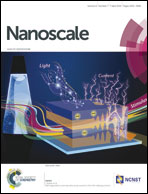A mechanical nanogate based on a carbon nanotube for reversible control of ion conduction†
Abstract
Control of mass transport through nanochannels is of critical importance in many nanoscale devices and nanofiltration membranes. The gates in biological channels, which control the transport of substances across cell membranes, can provide inspiration for this purpose. Gates in many biological channels are formed by a constriction ringed with hydrophobic residues which can prevent ion conduction even when they are not completely physically occluded. In this work, we use molecular dynamics simulations to design a nanogate inspired by this hydrophobic gating mechanism. Deforming a carbon nanotube (12,12) with an external force can form a hydrophobic constriction in the centre of the tube that controls ion conduction. The simulation results show that increasing the magnitude of the applied force narrows the constriction and lowers the fluxes of K+ and Cl− found under an electric field. With the exerted force larger than 5 nN, the constriction blocks the conduction of K+ and Cl− due to partial dehydration while allowing for a noticeable water flux. Ion conduction can revert back to the unperturbed level upon force retraction, suggesting the reversibility of the nanogate. The force can be exerted by available experimental facilities, such as atomic force microscope (AFM) tips. It is found that partial dehydration in a continuous water-filled hydrophobic constriction is enough to close the channel, while full dewetting is not necessarily required. This mechanically deformed nanogate has many potential applications, such as a valve in nanofluidic systems to reversibly control ion conduction and a high-performance nanomachine for desalination and water treatment.


 Please wait while we load your content...
Please wait while we load your content...